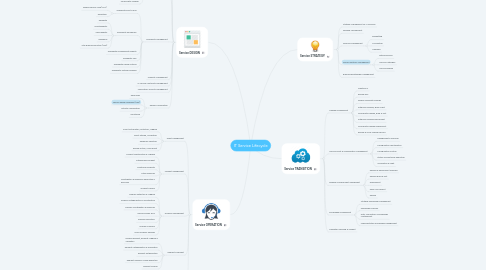
1. Service DESIGN
1.1. Service Catalogue Management
1.2. Service Level Management (SLM)
1.3. Supplier Management
1.3.1. Strategic Supplier
1.3.2. Tactical Supplier
1.3.3. Operational Supplier
1.3.4. Commodity Supplier
1.4. Availability Management
1.4.1. Availability end-to-end
1.4.1.1. Agreed Service Time (AST)
1.4.1.2. Downtime
1.4.2. Availability Komponen
1.4.2.1. Reliability
1.4.2.2. Maintainability
1.4.2.3. Serviceability
1.4.2.4. Resilience
1.4.2.5. Vital Business Function (VBF)
1.4.3. Availability Management Reports
1.4.4. Availability Plan
1.4.5. Availability Design Criteria
1.4.6. Availability Testing Schedule
1.5. Capacity Management
1.6. IT Service Continuity Management
1.7. Information Security Management
1.8. Design Coordination
1.8.1. Resources
1.8.2. Service Design Packages (SDP)
1.8.3. Activity Coordination
1.8.4. Monitoring
2. Service OPERATION
2.1. Event Management
2.1.1. Event Notification, Detection, Logging
2.1.2. Event Filtered, Correlation
2.1.3. Response Selection
2.1.4. Review Action, Close Event
2.2. Incident Management
2.2.1. Incident Identification & Logging
2.2.2. Categorising Incident
2.2.3. Prioritising Incidents
2.2.4. Initial Diagnosis
2.2.5. Investigation & Diagnosis; Resolution & Recovery
2.2.6. Incident Closure
2.3. Problem Management
2.3.1. Problem Detection & Logging
2.3.2. Problem Categorization & Prioritization
2.3.3. Problem Investigation & Diagnosis
2.3.4. Record Known Error
2.3.5. Problem Resolution
2.3.6. Problem Clousure
2.3.7. Major Problem Reviews
2.4. Request Fulfilment
2.4.1. Receive Request, Request Logging & Validation
2.4.2. Request Categorization & Priorization
2.4.3. Request Authorization
2.4.4. Request Review & Model Execution
2.4.5. Request Closure
2.5. Access Management
2.5.1. Request Access
2.5.2. Verification
2.5.3. Providing Rights
2.5.4. Monitoring Identity Status, Removing / Restricting Rights
2.5.5. Logging & Tracking Access
3. Service TRANSITION
3.1. Change Management
3.1.1. Create RFC
3.1.2. Review RFC
3.1.3. Assess & Evaluate Change
3.1.4. Authorize Change, Build & Test
3.1.5. Coordinate Change, Build & Test
3.1.6. Authorize Change Deployment
3.1.7. Coordinate Change Deployment
3.1.8. Review & Close Change Record
3.2. Service Asset & Configuration Management
3.2.1. Management & Planning
3.2.2. Configuration Identification
3.2.3. Configuration Control
3.2.4. Status Accounting & Reporting
3.2.5. Verification & Audit
3.3. Release & Deployment Mangement
3.3.1. Release & Deployment Planning
3.3.2. Release Build & Test
3.3.3. Deployment
3.3.4. Early Life Support
3.3.5. Review
3.4. Knowledge Management
3.4.1. Strategy Knowledge Management
3.4.2. Knowledge Transfer
3.4.3. Data, Information & Knowledge Management
3.4.4. Implementation Knowledge Management
3.5. Transation Planning & Support
4. Service STRATEGY
4.1. Strategy Management for IT Services
4.2. Demand Management
4.3. Financial Management
4.3.1. Budgetting
4.3.2. Accounting
4.3.3. Charging
4.4. Service Portfolio Management
4.4.1. Retired Service
4.4.2. Service Catalogue
4.4.3. Service Pipeline

